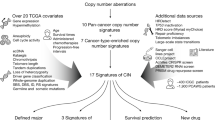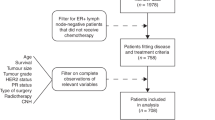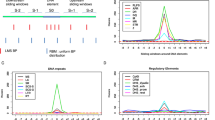Abstract
Chromosomal instability, which is a characteristic of many human cancers, contributes to intratumour heterogeneity and has been functionally implicated in resistance to taxane therapy in tumour models. However, defining the status of tumour chromosomal instability in a given tumour to test this hypothesis remains challenging. Measurements of numerical and structural chromosomal heterogeneity demonstrate that histological grade correlates with chromosomal instability in oestrogen receptor (ER)-positive breast cancer. Using data on adjuvant taxane therapy in women with breast cancer, we propose that patients with low-grade ER-positive tumours, which are thought to be chromosomally stable, might derive unexpected benefit from taxane therapy. We discuss the implications of the relationships between tumour grade, chromosomal instability and intratumour heterogeneity, the development of high-throughput methods to define tumour chromosomal instability and the potential use of chromosomal instability to tailor therapy.
This is a preview of subscription content, access via your institution
Access options
Subscribe to this journal
Receive 12 print issues and online access
$209.00 per year
only $17.42 per issue
Buy this article
- Purchase on Springer Link
- Instant access to full article PDF
Prices may be subject to local taxes which are calculated during checkout

Similar content being viewed by others
References
McGranahan, N., Burrell, R. A., Endesfelder, D., Novelli, M. R. & Swanton, C. Cancer chromosomal instability: therapeutic and diagnostic challenges. EMBO Rep. 13, 528–538 (2012).
Burrell, R. A. et al. Replication stress links structural and numerical cancer chromosomal instability. Nature 494, 492–496 (2013).
Rakha, E. A. et al. Breast cancer prognostic classification in the molecular era: the role of histological grade. Breast Cancer Res. 12, 207 (2010).
Pinder, S. E. et al. The importance of the histologic grade of invasive breast carcinoma and response to chemotherapy. Cancer 83, 1529–1539 (1998).
Fisher, E. R. et al. Pathobiology of preoperative chemotherapy: findings from the National Surgical Adjuvant Breast and Bowel (NSABP) protocol B-18. Cancer 95, 681–695 (2002).
Swanton, C. et al. Chromosomal instability determines taxane response. Proc. Natl Acad. Sci. USA 106, 8671–8676 (2009).
Harrison, M. & Swanton, C. Epothilones and new analogues of the microtubule modulators in taxane-resistant disease. Expert Opin. Invest. Drugs 17, 523–546 (2008).
Weaver, B. A. & Cleveland, D. W. Decoding the links between mitosis, cancer, and chemotherapy: the mitotic checkpoint, adaptation, and cell death. Cancer Cell 8, 7–12 (2005).
Cahill, D. P. et al. Mutations of mitotic checkpoint genes in human cancers. Nature 392, 300–303 (1998).
Sudo, T., Nitta, M., Saya, H. & Ueno, N. T. Dependence of paclitaxel sensitivity on a functional spindle assembly checkpoint. Cancer Res. 64, 2502–2508 (2004).
Anand, S., Penrhyn-Lowe, S. & Venkitaraman, A. R. AURORA-A amplification overrides the mitotic spindle assembly checkpoint, inducing resistance to Taxol. Cancer Cell 3, 51–62 (2003).
Nakayama, S. et al. Prediction of paclitaxel sensitivity by CDK1 and CDK2 activity in human breast cancer cells. Breast Cancer Res. 11, R12 (2009).
Inaba, S. et al. Synuclein gamma inhibits the mitotic checkpoint function and promotes chromosomal instability of breast cancer cells. Breast Cancer Res. Treat. 94, 25–35 (2005).
Swanton, C., Tomlinson, I. & Downward, J. Chromosomal instability, colorectal cancer and taxane resistance. Cell Cycle 5, 818–823 (2006).
Swanton, C. et al. Regulators of mitotic arrest and ceramide metabolism are determinants of sensitivity to paclitaxel and other chemotherapeutic drugs. Cancer Cell 11, 498–512 (2007).
Carter, S. L., Eklund, A. C., Kohane, I. S., Harris, L. N. & Szallasi, Z. A signature of chromosomal instability inferred from gene expression profiles predicts clinical outcome in multiple human cancers. Nat. Genet. 38, 1043–1048 (2006).
Juul, N. et al. Assessment of an RNA interference screen-derived mitotic and ceramide pathway metagene as a predictor of response to neoadjuvant paclitaxel for primary triple-negative breast cancer: a retrospective analysis of five clinical trials. Lancet Oncol. 11, 358–365 (2010).
McClelland, S. E., Burrell, R. A. & Swanton, C. Chromosomal instability: a composite phenotype that influences sensitivity to chemotherapy. Cell Cycle 8, 3262–3266 (2009).
Bouchet, B. P. et al. Paclitaxel resistance in untransformed human mammary epithelial cells is associated with an aneuploidy-prone phenotype. Br. J. Cancer 97, 1218–1224 (2007).
Walther, A., Houlston, R. & Tomlinson, I. Association between chromosomal instability and prognosis in colorectal cancer: a meta-analysis. Gut 57, 941–950 (2008).
Kronenwett, U. et al. Improved grading of breast adenocarcinomas based on genomic instability. Cancer Res. 64, 904–909 (2004).
Habermann, J. K. et al. The gene expression signature of genomic instability in breast cancer is an independent predictor of clinical outcome. Int. J. Cancer 124, 1552–1564 (2009).
Cahill, D. P., Kinzler, K. W., Vogelstein, B. & Lengauer, C. Genetic instability and darwinian selection in tumours. Trends Cell Biol. 9, M57–M60 (1999).
Duesberg, P., Stindl, R. & Hehlmann, R. Explaining the high mutation rates of cancer cells to drug and multidrug resistance by chromosome reassortments that are catalyzed by aneuploidy. Proc. Natl Acad. Sci. USA 97, 14295–14300 (2000).
Roschke, A. V. et al. Karyotypic complexity of the NCI-60 drug-screening panel. Cancer Res. 63, 8634–8647 (2003).
Roschke, A. V. et al. Karyotypic “state” as a potential determinant for anticancer drug discovery. Proc. Natl Acad. Sci. USA 102, 2964–2969 (2005).
Roschke, A. V. & Kirsch, I. R. Targeting cancer cells by exploiting karyotypic complexity and chromosomal instability. Cell Cycle 4, 679–682 (2005).
Roschke, A. V. & Kirsch, I. R. Targeting karyotypic complexity and chromosomal instability of cancer cells. Curr. Drug Targets 11, 1341–1350 (2010).
Bergers, E., van Diest, P. J. & Baak, J. P. Tumour heterogeneity of DNA cell cycle variables in breast cancer measured by flow cytometry. J. Clin. Pathol. 49, 931–937 (1996).
Gerlinger, M. et al. Intratumor heterogeneity and branched evolution revealed by multiregion sequencing. N. Engl. J. Med. 366, 883–892 (2012).
Lingle, W. L. et al. Centrosome amplification drives chromosomal instability in breast tumor development. Proc. Natl Acad. Sci. USA 99, 1978–1983 (2002).
Geigl, J. B., Obenauf, A. C., Schwarzbraun, T. & Speicher, M. R. Defining 'chromosomal instability'. Trends Genet. 24, 64–69 (2008).
Nowak, A. K., Wilcken, N. R., Stockler, M. R., Hamilton, A. & Ghersi, D. Systematic review of taxane-containing versus non-taxane-containing regimens for adjuvant and neoadjuvant treatment of early breast cancer. Lancet Oncol. 5, 372–380 (2004).
Ghersi, D., Wilcken, N. & Simes, R. J. A systematic review of taxane-containing regimens for metastatic breast cancer. Br. J. Cancer 93, 293–301 (2005).
Konecny, G. E. et al. Her-2/neu gene amplification and response to paclitaxel in patients with metastatic breast cancer. J. Natl Cancer Inst. 96, 1141–1151 (2004).
Hayes, D. F. et al. HER2 and response to paclitaxel in node-positive breast cancer. N. Engl. J. Med. 357, 1496–1506 (2007).
Penault-Llorca, F. et al. Ki67 expression and docetaxel efficacy in patients with estrogen receptor-positive breast cancer. J. Clin. Oncol. 27, 2809–2815 (2009).
Paradiso, A. et al. Biomarkers predictive for clinical efficacy of taxol-based chemotherapy in advanced breast cancer. Ann. Oncol. 16 (Suppl. 4), iv14–iv19 (2005).
Van Poznak, C. et al. Assessment of molecular markers of clinical sensitivity to single-agent taxane therapy for metastatic breast cancer. J. Clin. Oncol. 20, 2319–2326 (2002).
Khan, S. H. & Wahl, G. M. p53 and pRb prevent rereplication in response to microtubule inhibitors by mediating a reversible G1 arrest. Cancer Res. 58, 396–401 (1998).
Lissoni, P. et al. Chemotherapy and angiogenesis in advanced cancer: vascular endothelial growth factor (VEGF) decline as predictor of disease control during taxol therapy in metastatic breast cancer. Int. J. Biol. Markers 15, 308–311 (2000).
Grant, D. S., Williams, T. L., Zahaczewsky, M. & Dicker, A. P. Comparison of antiangiogenic activities using paclitaxel (taxol) and docetaxel (taxotere). Int. J. Cancer 104, 121–129 (2003).
Kosaka, T. et al. Analysis of epidermal growth factor receptor gene mutation in patients with non-small cell lung cancer and acquired resistance to gefitinib. Clin. Cancer Res. 12, 5764–5769 (2006).
Turke, A. B. et al. Preexistence and clonal selection of MET amplification in EGFR mutant NSCLC. Cancer Cell 17, 77–88 (2010).
Diaz, L. A. Jr et al. The molecular evolution of acquired resistance to targeted EGFR blockade in colorectal cancers. Nature 486, 537–540 (2012).
Elston, C. W. & Ellis, I. O. Pathological prognostic factors in breast cancer. I. The value of histological grade in breast cancer: experience from a large study with long-term follow-up. Histopathology 19, 403–410 (1991).
Bloom, H. J. & Richardson, W. W. Histological grading and prognosis in breast cancer; a study of 1409 cases of which 359 have been followed for 15 years. Br. J. Cancer 11, 359–377 (1957).
Coschi, C. H. & Dick, F. A. Chromosome instability and deregulated proliferation: an unavoidable duo. Cell. Mol. Life Sci. 69, 2009–2024 (2012).
Birkbak, N. J. et al. Paradoxical relationship between chromosomal instability and survival outcome in cancer. Cancer Res. 71, 3447–3452 (2011).
Owainati, A. A. et al. Tumour aneuploidy, prognostic parameters and survival in primary breast cancer. Br. J. Cancer 55, 449–454 (1987).
Chassevent, A. et al. S-phase fraction and DNA ploidy in 633 T1T2 breast cancers: a standardized flow cytometric study. Clin. Cancer Res. 7, 909–17 (2001).
Martinez-Arribas, F. et al. The S-phase fraction of the aneuploid cell subpopulation is the biologically relevant one in aneuploid breast cancers. Breast Cancer Res. Treat. 92, 77–80 (2005).
Gazic, B. et al. S-phase fraction determined on fine needle aspirates is an independent prognostic factor in breast cancer—a multivariate study of 770 patients. Cytopathology 19, 294–302 (2008).
O'Reilly, S. M. et al. DNA index, S-phase fraction, histological grade and prognosis in breast cancer. Br. J. Cancer 61, 671–674 (1990).
Toikkanen, S., Joensuu, H. & Klemi, P. The prognostic significance of nuclear DNA content in invasive breast cancer--a study with long-term follow-up. Br. J. Cancer 60, 693–700 (1989).
Kapranos, N., Kounelis, S., Karantasis, H. & Kouri, E. Numerical aberrations of chromosomes 1 and 7 by fluorescent in situ hybridization and DNA ploidy analysis in breast cancer. Breast J. 11, 448–453 (2005).
Sauer, T., Beraki, K., Jebsen, P. W., Ormerod, E. & Naess, O. Ploidy analysis by in situ hybridization of interphase cell nuclei in fine-needle aspirates from breast carcinomas: correlation with cytologic grading. Diagn. Cytopathol. 17, 267–271 (1997).
Persons, D. L. et al. Chromosome-specific aneusomy in carcinoma of the breast. Clin. Cancer Res. 2, 883–888 (1996).
Tsuda, H., Takarabe, T. & Hirohashi, S. Correlation of numerical and structural status of chromosome 16 with histological type and grade of non-invasive and invasive breast carcinomas. Int. J. Cancer 84, 381–387 (1999).
Szász, A. M. et al. The CIN4 chromosomal instability qPCR classifier defines tumor aneuploidy and stratifies outcome in grade 2 breast cancer. PLoS ONE 8, e56707 (2013).
Roylance, R. et al. Relationship of extreme chromosomal instability with long-term survival in a retrospective analysis of primary breast cancer. Cancer Epidemiol. Biomarkers Prev. 20, 2183–2194 (2011).
Dellas, A., Torhorst, J., Schultheiss, E., Mihatsch, M. J. & Moch, H. DNA sequence losses on chromosomes 11p and 18q are associated with clinical outcome in lymph node-negative ductal breast cancer. Clin. Cancer Res. 8, 1210–1216 (2002).
Wistuba, I. I., Gelovani, J. G., Jacoby, J. J., Davis, S. E. & Herbst, R. S. Methodological and practical challenges for personalized cancer therapies. Nat. Rev. Clin. Oncol. 8, 135–141 (2011).
Peto, R. et al. Comparisons between different polychemotherapy regimens for early breast cancer: meta-analyses of long-term outcome among 100,000 women in 123 randomised trials. Lancet 379, 432–444 (2012).
Palmieri, C. & Jones, A. The 2011 EBCTCG polychemotherapy overview. Lancet 379, 390–392 (2012).
Reis-Filho, J. S. & Pusztai, L. Gene expression profiling in breast cancer: classification, prognostication, and prediction. Lancet 378, 1812–1823 (2011).
Weigelt, B., Pusztai, L., Ashworth, A. & ReisFilho, J. S. Challenges translating breast cancer gene signatures into the clinic. Nat. Rev. Clin. Oncol. 9, 58–64 (2012).
Martín, M. et al. PAM50 proliferation score as a predictor of weekly paclitaxel benefit in breast cancer. Breast Cancer Res. Treat. 138, 457–466 (2013).
Pfisterer, J. et al. DNA flow cytometry in node-positive breast cancer. Prognostic value and correlation with morphologic and clinical factors. Anal. Quant. Cytol. Histol. 17, 406–412 (1995).
Ruibal, A. et al. Histological grade in breast cancer: association with clinical and biological features in a series of 229 patients. Int. J. Biol. Markers 16, 56–61 (2001).
Cajulis, R. S., Kotliar, S., Haines, G. K., Frias-Hidvegi, D. & O'Gorman, M. Comparative study of interphase cytogenetics, flow cytometric analysis, and nuclear grade of fine-needle aspirates of breast carcinoma. Diagn. Cytopathol. 11, 151–158 (1994).
Auer, G. U., Fallenius, A. G., Erhardt, K. Y. & Sundelin, B. S. Progression of mammary adenocarcinomas as reflected by nuclear DNA content. Cytometry 5, 420–425 (1984).
Fallenius, A. G., Auer, G. U. & Carstensen, J. M. Prognostic significance of DNA measurements in 409 consecutive breast cancer patients. Cancer 62, 331–341 (1988).
Fallenius, A. G., Franzén, S. A. & Auer, G. U. Predictive value of nuclear DNA content in breast cancer in relation to clinical and morphologic factors. A retrospective study of 227 consecutive cases. Cancer 62, 521–530 (1988).
Speicher, M. R. & Carter, N. P. The new cytogenetics: blurring the boundaries with molecular biology. Nat. Rev. Genet. 6, 782–792 (2005).
Darzynkiewicz, Z., Halicka, H. D. & Zhao, H. Analysis of cellular DNA content by flow and laser scanning cytometry. Adv. Exp. Med. Biol. 676, 137–147 (2010).
Pinkel, D. & Albertson, D. G. Array comparative genomic hybridization and its applications in cancer. Nat. Genet. 37 (Suppl.), S11–S17 (2005).
Acknowledgements
The authors would like to acknowledge Judith Bliss (Cancer Research UK Section of Clinical Trials, The Institute of Cancer Research, Sutton, UK), David Endesfelder (Helmholtz Zentrum München, Neuherberg, Germany), Nicolai Birkbak (Centre for Biological Sequence Analysis, Technical University of Denmark, Lyngby, Denmark), Ian O. Ellis (University of Nottingham, Department of Histopathology, Nottingham City Hospital, Nottingham, UK), Andy Hanby (Leeds Institute of Molecular Medicine, St James's University Hospital, Leeds, UK), Ian Tomlinson (Wellcome Trust Centre for Human Genetics, Oxford, UK), Maik Kschischo (University of Applied Sciences, Mathematics and Techniques, Remagen, Germany), Janina Kulka (2nd Department of Pathology, Semmelweis University, Budapest, Hungary), Zoltan Szallasi (Centre for Biological Sequence Analysis, Technical University of Denmark, Lyngby, Denmark), Andrea L. Richardson (Dana–Farber Cancer Institute, Boston, USA), Andrew Rowan (Translational Cancer Therapeutics Laboratory, Cancer Research UK, London Research Institute, London, UK) and members of the TRANS–TACT consortium for helpful advice during preparation of the manuscript. The authors would also like to acknowledge Rebecca Burrell and Nicholas McGranahan for help in preparing the article figure. C. Swanton is supported by the Breast Cancer Research Foundation, Medical Research Council UK and Cancer Research UK.
Author information
Authors and Affiliations
Contributions
R. P. A'Hern and M. Jamal-Hanjani contributed equally to the preparation of the manuscript. R. P. A'Hern, M. Jamal-Hanjani, J. S. Reis-Filho and C. Swanton researched the data for the article and wrote the manuscript. All authors contributed to a discussion of the article's content and edited the manuscript before submission.
Corresponding authors
Supplementary information
Supplementary Box 1
Calculating the number needed to treat with taxane-based chemotherapy to save one breast cancer death (DOC 32 kb)
Rights and permissions
About this article
Cite this article
A'Hern, R., Jamal-Hanjani, M., Szász, A. et al. Taxane benefit in breast cancer—a role for grade and chromosomal stability. Nat Rev Clin Oncol 10, 357–364 (2013). https://doi.org/10.1038/nrclinonc.2013.67
Published:
Issue Date:
DOI: https://doi.org/10.1038/nrclinonc.2013.67
This article is cited by
-
Histone deacetylase (HDAC) 9: versatile biological functions and emerging roles in human cancer
Cellular Oncology (2021)
-
Mps1 inhibitors synergise with low doses of taxanes in promoting tumour cell death by enhancement of errors in cell division
British Journal of Cancer (2018)
-
Can oncology recapitulate paleontology? Lessons from species extinctions
Nature Reviews Clinical Oncology (2015)



